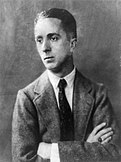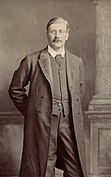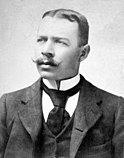| << | Today's featured articles for June 2022 | >> | ||||
|---|---|---|---|---|---|---|
| Su | Mo | Tu | We | Th | Fr | Sa |
| 1 | 2 | 3 | 4 | |||
| 5 | 6 | 7 | 8 | 9 | 10 | 11 |
| 12 | 13 | 14 | 15 | 16 | 17 | 18 |
| 19 | 20 | 21 | 22 | 23 | 24 | 25 |
| 26 | 27 | 28 | 29 | 30 | ||
June 1
Don Dunstan (1926–1999) was a South Australian politician. He was first elected as Member for Norwood in 1953 and rose to prominence in the late 1950s for campaigning against the death penalty. He became the attorney-general of South Australia in 1965 and premier on 1 June 1967. After resigning in 1968, he returned as premier after the 1970 election, the first of four successive election wins. His administration was socially progressive, enacting anti-discrimination laws, expanding voting rights, and increasing the public service sector. However, the economy began to stagnate and the burgeoning public service generated claims of waste. His popularity decreased in 1978 when unsubstantiated rumours of corruption and personal impropriety began, and he was accused of improperly interfering with a judicial investigation. In 1979 he collapsed from ill health and resigned from the premiership shortly afterward. He continued to campaign for progressive social policy until his death in 1999. (Full article...)
June 2
Loev is a 2015 Indian romantic drama film written and directed by Sudhanshu Saria. It stars Dhruv Ganesh and Shiv Panditt (pictured) as two friends who set off to the Western Ghats for a weekend trip. Focusing on their complex emotional and sexual relationship, the film drew heavily from Saria's personal experiences. Its title is a deliberate misspelling of and is pronounced like the word "love". The cinematographer Sherri Kauk shot the film in the summer of 2014 in Mahabaleshwar in the Western Ghats in peninsular India, and in Mumbai. Loev had its world premiere at the 2015 Tallinn Black Nights Film Festival in Estonia, its North American premiere at the 2016 South by Southwest Film Festival in Texas and its Indian premiere at the 2016 Mumbai International Film Festival. It won the Audience Award at the 2016 Tel Aviv International LGBT Film Festival. Ganesh died from tuberculosis prior to the film's release. Loev was released on Netflix on 1 May 2017. (Full article...)
June 3

Super Mario Bros.: The Lost Levels is a platform game released on June 3, 1986, as a sequel to Super Mario Bros. (1985) by Nintendo. It was designed to be similar in style and gameplay for players who had mastered the original. Players control Mario or Luigi to jump between platforms and rescue the Princess from Bowser. It became the most popular game in Japan for the Famicom Disk System, selling about 2.5 million copies. Deeming it too difficult for North American audiences, Nintendo of America instead retrofitted another game as the region's sequel. The Japanese sequel was renamed as The Lost Levels in the 1993 compilation Super Mario All-Stars, the sequel's first international release. Reviewers regarded the sequel as an extension of the original's difficulty progression. The Lost Levels is remembered as among the most difficult Nintendo games and regarded as a precursor to the franchise's Kaizo subculture in which fans create and share ROM hacks featuring nearly impossible levels. (Full article...)
June 4
Banksia canei, the mountain banksia, is a shrub of the subalpine areas of Australia's Great Dividing Range, between Melbourne and Canberra. First described in 1967, it superficially resembles B. marginata, but is more closely related to another subalpine species, B. saxicola. Although no subspecies are recognised, four geographically isolated populations have been described. There is significant variation in the shape of the leaves between populations. B. canei is generally encountered as a shrub that grows up to 3 m (10 ft) high, with many branches and narrow leaves, and with yellow inflorescences (flower spikes) from late summer to early winter. Old flowers fall off the spikes, and up to 150 seed-bearing follicles develop, which mostly remain closed until burnt in a bushfire. Birds such as the yellow-tufted honeyeater and various insects forage among the flower spikes. B. canei is frost tolerant in cultivation, but copes less well with aridity or humidity, and is often short-lived in gardens. (Full article...)
June 5
The Four Freedoms is a series of four 1943 oil paintings by the American artist Norman Rockwell (pictured). The paintings—Freedom of Speech, Freedom of Worship, Freedom from Want and Freedom from Fear—refer to Franklin D. Roosevelt's January 1941 Four Freedoms State of the Union address in which he identified essential human rights that should be universally protected, a theme which became part of the United Nations Charter. The paintings were reproduced in The Saturday Evening Post alongside essays by prominent thinkers of the day. They became the highlight of a year-long touring exhibition to promote war bonds sold to support the American war effort, which raised over $132 million. The paintings, now in the Norman Rockwell Museum, are his best-known works, but critical review has not been entirely positive. Freedom from Want became emblematic of what is now known as the "Norman Rockwell Thanksgiving", with family at table as a turkey is served. (This article is part of a featured topic: Four Freedoms.)
June 6
David Scott (born June 6, 1932) is a retired NASA astronaut, the seventh person to walk on the Moon and the only commander of a successful lunar landing mission still alive. Born in Texas, he attended West Point and was commissioned in the Air Force, flying as a fighter pilot in Europe, and then as a test pilot. He was selected in 1963 as one of NASA's third group of astronauts. He first flew into space in 1966 as pilot of Gemini 8 alongside Neil Armstrong. Scott spent ten days in orbit in March 1969 as command module pilot of Apollo 9. He made his third and final spaceflight in 1971 as commander of Apollo 15, the fourth crewed lunar landing, and explored the Moon with James Irwin for three days. Scott retired from the Air Force in 1975 with the rank of colonel. After serving as director of NASA's Dryden Flight Research Center, he retired from the agency in 1977, entering the private sector. He served as a consultant for several films about the space program, including Apollo 13. (Full article...)
June 7
Lake Estancia was a body of water in the Estancia Valley, in the center of the U.S. state of New Mexico. Mostly fed by creek and groundwater from the Manzano Mountains, the lake had diverse fauna, including cutthroat trout. It appears to have formed when a river system broke up. It reached a maximum water level (highstand) presumably during the Illinoian glaciation and subsequently fluctuated between a desiccated basin and fuller stages. Wind-driven erosion has excavated depressions in the former lakebed that are in part filled with playas (dry lake beds). The lake was one of several pluvial lakes in southwestern North America that developed during the late Pleistocene. Their formation has been variously attributed to decreased temperatures during the ice age and increased precipitation; a shutdown of the thermohaline circulation and the Laurentide Ice Sheet altered atmospheric circulation patterns and increased precipitation in the region. The lake has yielded a good paleoclimatic record. (Full article...)
June 8
The white swamphen (Porphyrio albus) was a rail found on Lord Howe Island, east of the Australian mainland. All contemporary accounts and illustrations were produced between 1788 and 1790, when the bird was first encountered by British ship crews. Today, two specimens exist: one in World Museum (pictured) in Liverpool, England, and the holotype in the Natural History Museum of Vienna. It is thought to have been most similar to the Australasian swamphen. The white swamphen was 36 to 55 cm (14 to 22 in) long. Contemporary accounts indicate that individual bird plumage was white, blue, or mixed blue-and-white. The bird's bill, frontal shield and legs were red, and it had a claw (or spur) on its wing. It was probably either flightless or a poor flier; this and its docility made the bird easy prey for visiting humans, who killed it with sticks. Reportedly once common, the species may have been hunted to extinction before 1834, when Lord Howe Island was settled. (Full article...)
June 9
On the Job is a 2013 Philippine crime-thriller film conceived and directed by Erik Matti (pictured), who co-wrote it with Michiko Yamamoto. Starring Gerald Anderson, Joel Torre, Joey Marquez and Piolo Pascual, it tells the story of two prisoners (Anderson and Torre) who are temporarily freed to carry out political executions, and two law enforcers (Marquez and Pascual) investigating a case connected to the prison gun-for-hire business. Star Cinema initially refused to produce the film due to its violent content, but in 2012 agreed to co-produce it with Reality Entertainment, Matti's independent film company. Filming took place in Manila and lasted 33 days, on a production budget of 47 million pesos (about US$1.1 million). On the Job was praised at the Directors' Fortnight at the 2013 Cannes Film Festival. The film was released in the Philippines on August 28, 2013, and in the United States and Canada on September 27. It received positive reviews from foreign and domestic critics. (Full article...)
June 10

Mosasaurus is a genus of mosasaurs, an extinct group of aquatic scaly reptiles. It lived from about 82 to 66 million years ago during the Late Cretaceous. Its earliest fossils were found as skulls near the River Meuse (Mosa in Latin). In 1808, Georges Cuvier concluded that the skulls belonged to a giant marine lizard with similarities to monitors but otherwise unlike any known living animal, supporting the then-developing idea of extinction. Scientists continue to debate whether its closest living relatives are monitors or snakes. Mosasaurus had jaws capable of swinging back and forth and was capable of powerful bites, using dozens of teeth adapted for cutting prey. Its four limbs were shaped into paddles to steer underwater. Mosasaurus was a predator with excellent vision but a poor sense of smell, and a high metabolic rate suggesting it was warm-blooded. It lived in much of the Atlantic and in a wide range of oceanic climates including tropical, subtropical, temperate, and subpolar. (Full article...)
June 11
Hurricane Leslie (2018) was a cyclone of tropical origin, the strongest to strike the Iberian Peninsula since 1842. A large, long-lived, and very erratic tropical cyclone, Leslie developed from an extratropical cyclone that was situated over the northern Atlantic on 22 September. It became a Category 1 hurricane early on 3 October before falling to tropical storm intensity late on 4 October. After re-intensifying, Leslie reached hurricane status for the second time on 10 October, reaching peak intensity two days later and passing between the Azores and Madeira. It thereafter weakened, making landfall over central Portugal before dissipating by 16 October over Spain. The storm was responsible for 17 deaths in mainland Europe, including 2 direct deaths in Portugal and 15 indirect deaths in France. Over 300,000 citizens were left without power in Portugal, with damage there estimated to be about €120 million (US$145 million). The storm and a cold front also caused flooding in France and Spain. (Full article...)
June 12
The Tower House, in the district of Holland Park in Kensington and Chelsea, London, is a late Victorian townhouse built between 1875 and 1881 by the architect and designer William Burges as his personal residence. Designed in the French Gothic Revival style, it echoes elements of Burges's earlier work. The house was built of red brick by the Ashby Brothers, with a distinctive cylindrical tower and conical roof. The interior was decorated by members of Burges's long-standing team of craftsmen including Thomas Nicholls and Henry Stacy Marks. The house retains most of its internal structural decoration, but much of the furniture, fittings and contents that Burges designed have been dispersed. Many items, including the Great Bookcase, the Zodiac settle, the Golden Bed and the Red Bed, are now in institutions such as The Higgins Bedford and the Victoria and Albert Museum. The house was designated a Grade I listed building in 1949. (Full article...)
June 13
The 1881 world tour of King Kalākaua (pictured) made him the first monarch to circumnavigate the globe. His agenda was to negotiate contract labor for the Kingdom of Hawaii's sugar plantations, with hopes of saving the dwindling Native Hawaiian population by drawing immigration from Asia-Pacific nations. Rumors circulated that the King secretly intended to use the trip to sell the Hawaiian Islands. He visited American legislators, had an audience with Pope Leo XIII in Rome, and met with European and Asian heads of state. In between negotiations, Kalākaua and his companions visited tourist sites and attended local Masonic lodge meetings. As a result of his visit with Thomas Edison, Iolani Palace became the first building in Hawaii with electric lighting. The King's amiable personality generated worldwide goodwill, and he succeeded in increasing Hawaii's labor force with Japanese workers. Their arrival was commemorated a century later with a new statue of Kalākaua in Waikiki. (Full article...)
June 14
"I've Just Seen a Face" is a Beatles song written and sung by Paul McCartney (pictured), first released on the album Help! in August 1965. A cheerful ballad of love at first sight, it may have been inspired by McCartney's relationship with actress Jane Asher. The Beatles recorded it on 14 June 1965 at EMI Studios in London, on the same day "I'm Down" and "Yesterday" were recorded. The song fuses country and western with other musical genres, including folk rock, folk, pop rock and bluegrass. Several reviewers have described the song in favourable terms, highlighting its rhyming lyricism and McCartney's vocal delivery, and describing it as an overlooked song. It replaced "Drive My Car" on the North American version of Rubber Soul in December 1965, furthering the album's identity as a folk rock work, although some commentators viewed this change as masking the band's late-1965 creative developments. It was among the first Beatles songs McCartney played live with his group Wings. (Full article...)
June 15
The pronunciation of GIF has been disputed since the 1990s. GIF, an acronym for the Graphics Interchange Format, is popularly pronounced in English as a one-syllable word. The most common pronunciations in English are /dʒɪf/ (with a soft g as in gin) and /ɡɪf/ (with a hard g as in gift), differing in the phoneme represented by the letter G. Many public figures and institutions have taken sides in the debate; Steve Wilhite, the file format's creator, gave a speech at the 2013 Webby Awards (slide pictured) arguing that only the soft g pronunciation is correct. Polls show that the hard g pronunciation is more common, although the frequency of each pronunciation varies by region; in addition, some speakers enunciate each letter in GIF, making it /dʒiː aɪ ɛf/ . English dictionaries generally accept both main alternatives as valid, and linguistic analyses show no clear advantage for either main pronunciation based on the pronunciation frequencies of similar English words. (Full article...)
June 16
Olive Morris (1952–1979) was a Jamaican-born and British-based community leader and activist. She participated in the black nationalist, feminist and squatters' rights campaigns of the 1970s. She joined the British Black Panthers, occupied buildings in Brixton, South London, and became a key organiser in the Black Women's Movement in the United Kingdom. In London, Morris co-founded the Brixton Black Women's Group and the Organisation of Women of African and Asian Descent; when she studied at the Victoria University of Manchester, she was involved in the Manchester Black Women's Co-operative and also travelled to China with the Society for Anglo-Chinese Understanding. After graduating, Morris returned to Brixton and worked at the Brixton Community Law Centre. She then received a diagnosis of non-Hodgkin lymphoma and died shortly afterwards at the age of 27. Her life and work have been commemorated by both official organisations and the activist group Remembering Olive Collective. (Full article...)
June 17

The Battle of St. Charles was fought on June 17, 1862, at St. Charles, Arkansas, during the American Civil War. Earlier in 1862, a force commanded by Samuel R. Curtis, a major general of the Union Army, became bogged down in northern Arkansas. A Union relief force was sent up the White River to resupply Curtis. The Confederates had constructed fortifications near St. Charles. An infantry unit was sent ashore to attack the fortifications on land, while Union ships attacked from the river. During the fight, a Confederate fired what has been referred to as the deadliest shot of the war, striking the ironclad USS Mound City, puncturing one of its steam drums, and filling the ship with scalding steam (depicted), killing 105 and wounding 25. Only about 25 aboard escaped unhurt. The infantrymen on land took the Confederate position. The supply mission was unable to reach Curtis, and withdrew back down the river. Curtis's army then cut loose from their supply line and marched to Helena, Arkansas. (Full article...)
June 18
Frank Russell, 2nd Earl Russell (1865–1931), was a British nobleman, barrister and politician, the older brother of the philosopher Bertrand Russell. In his youth, he enjoyed four happy years at Winchester College, but was dismissed from Balliol College, Oxford. He married Mabel Scott in 1890, but they soon separated. Unable to get an English divorce, in 1900, he became the first celebrity to get one in Nevada, and remarried there, but the divorce was invalid in England. In June 1901, he was arrested for bigamy, and was convicted before the House of Lords, the last time a peer was convicted by the Lords. His second marriage ended after he fell in love with the novelist Elizabeth von Arnim; they wed in 1916. The couple soon separated, though they did not divorce. Russell was given junior office in the second MacDonald government in 1929, and served until his death. Frank Russell is obscure compared to his brother, and his marital difficulties led to his being dubbed the "Wicked Earl". (Full article...)
June 19
The 1838 Jesuit slave sale was agreed to on June 19 when the Maryland province of the Society of Jesus entered into a contract to sell 272 slaves to two Louisiana planters for $115,000. This was the culmination of a long-running debate among the Jesuits over whether to keep, sell, or manumit their slaves. In 1836, the Jesuit superior general authorized the sale on three conditions: the slaves must be permitted to practice their Catholic faith, the families must not be separated, and the proceeds must only be used to support Jesuits in training. It soon became clear that the conditions had not been met; the new owners separated families and did not allow most of the slaves to carry on their faith. The Jesuits were only partially paid, many years late. For humanitarian reasons, only 206 slaves were delivered. Many Jesuits were outraged by the sale, and the superior general removed the provincial superior for disobeying orders and promoting scandal, exiling him to Nice for several years. (Full article...)
June 20
Final Fantasy Tactics is a tactical role-playing game developed and published by Square for the PlayStation video game console. Sony Computer Entertainment published the game in Japan on June 20, 1997, and the United States on January 28, 1998. It is the first game of the Tactics series within the Final Fantasy franchise, and the first entry set in the fictional world of Ivalice. The story follows Ramza Beoulve, who is placed in the middle of a military conflict between two noble factions coveting the throne of the kingdom. Production began in 1995 by Yasumi Matsuno, who was the director and writer. Final Fantasy series creator Hironobu Sakaguchi (pictured) was the producer and Hiroyuki Ito designed the battles. Final Fantasy Tactics received critical acclaim, garnered a cult following, and has been cited as one of the greatest video games of all time. An enhanced port of the game, Final Fantasy Tactics: The War of the Lions, was released in 2007. (This article is part of a featured topic: Ivalice.)
June 21
Woodleigh MRT station is an underground Mass Rapid Transit station on the North East line in Bidadari, Singapore. The station is underneath Upper Serangoon Road, near the junction with Upper Aljunied Road. Surrounding points of interest include Stamford American International School and Avon Park. The station also serves the developing Bidadari Estate and Woodleigh Residences (pictured). Woodleigh was among the 16 North East line stations first announced in March 1996. Despite being completed along with the rest of the line in June 2003, the station remained closed due to the lack of local development. It eventually opened on 20 June 2011. As with most of the North East line stations, it is a designated Civil Defence shelter. Woodleigh station features an Art-in-Transit public artwork Slow Motion by April Ng on thirty zinc panels, depicting commuters going about their daily lives. (Full article...)
June 22
Lancaster's chevauchée of 1356 in Normandy was an English offensive directed by Henry, Earl of Lancaster (depicted), as part of the Hundred Years' War. The offensive took the form of a chevauchée, a large-scale mounted raid, and lasted from 22 June to 13 July 1356. Lancaster landed in the Cotentin and pillaged and burnt his way eastward across the Duchy of Normandy with 2,300 men. John II of France moved to Rouen with a much stronger force to intercept Lancaster, but the English turned south after relieving and re-victualling the besieged friendly citadel of Pont-Audemer. They resupplied another friendly fortification, Breteuil, then stormed and sacked the important town of Verneuil-sur-Avre before retreating. John pursued, but bungled several opportunities to bring the English to battle. In 22 days the English travelled 330 miles (530 km), a remarkable effort for the period. The expedition seized a large amount of loot, damaged the French economy and prestige, and cemented new alliances. (Full article...)
June 23
The 2007 AT&T 250 was a NASCAR Busch Series stock car race that took place on June 23, 2007. Held at the Milwaukee Mile in West Allis, Wisconsin, the race was the 17th of 35 in the 2007 season of the Busch Series. Aric Almirola (pictured) of Joe Gibbs Racing was the listed winner of the race. Gibbs intended for NASCAR Nextel Cup Series regular Denny Hamlin to run the race, but the Cup Series was racing that weekend at Sonoma Raceway in Sonoma, California, and Hamlin did not arrive in time to start the race. Almirola started instead and ran the first 59 laps before he was pulled out of the car under caution; Hamlin finished the race and came from behind to win after losing a lap to the leaders during the driver change. NASCAR rules state that the driver who starts the race gets credit for the result, making Almirola the official race winner. The driver change frustrated Almirola, who proceeded to leave the track before the race ended. (Full article...)
June 24
The International Conference on the Holocaust and Genocide was the first major conference in the field of genocide studies and marked the shift from viewing genocide as an irrational phenomenon to one that could be studied and understood. It was held at the Hilton Hotel in Tel Aviv on 20–24 June 1982 and was initially organized by Israel Charny, Elie Wiesel, and Shamai Davidson. The Turkish government tried to have the conference cancelled because it included presentations on the Armenian genocide, which Turkey denies. Turkey threatened to close its borders to Syrian and Iranian Jews fleeing persecution. In response, the Israeli government called participants, claiming the conference was cancelled and asking them not to attend. The official Israeli Holocaust memorial and Tel Aviv University withdrew, as did many high-profile participants including Wiesel. The organizers refused to remove the Armenian genocide from the program and held the conference with fewer participants than planned. (Full article...)
June 25
The Thing is a 1982 American science fiction horror film directed by John Carpenter (pictured) and written by Bill Lancaster. Based on the 1938 John W. Campbell Jr. novella Who Goes There?, it tells the story of American researchers in Antarctica who encounter a parasitic extraterrestrial life-form that assimilates and imitates other organisms. The group is overcome by paranoia and conflict as they learn that they can no longer trust each other. The film stars Kurt Russell and also features A. Wilford Brimley, T. K. Carter, David Clennon, and Keith David. Of the film's $15 million budget, $1.5 million was spent on Rob Bottin's creature effects, a mixture of chemicals, food products, rubber, and mechanical parts used to represent an alien capable of taking on any form. The Thing was released on June 25, 1982, to very negative reviews and earned $19.6 million during its theatrical run, but has been favorably reappraised. It found an audience when released on home video and television. (Full article...)
June 26
J. K. Rowling is a pen name of Joanne Rowling, the British author of the children's fantasy series Harry Potter, the crime series Cormoran Strike and other works. Before her first Potter novel was published on 26 June 1997, her mother died from multiple sclerosis (MS) in 1990 and she lived on state assistance as a single parent after her marriage failed in 1993. Separation and loss are reflected in the Potter novels, with death and the divide between good and evil as central themes. Despite receiving mixed reviews for perceived conventional writing, Rowling became the world's highest-paid author by 2008. The series has sold over 500 million copies and spawned a media franchise including films and video games. Rowling has used her wealth to advance political causes, as well as charitable causes centred around MS, women and children. Her views on transgender rights have led to controversy, with critics deeming them transphobic. She has received many accolades for literature and philanthropy. (Full article...)
June 27
Will P. Brady (1876–1943) was an American lawyer, the first district attorney for Texas's 70th judicial district from 1909 to around 1914, and the judge for the El Paso County Court at Law from 1917 to 1919. Brady was born to a pioneering Austin family and grew up there. After service as a teacher in Travis County, Texas, he served as county school superintendent from 1900 to 1904. He then became a lawyer, and spent several years in private practice. As district attorney, Brady prosecuted several high-profile murder cases, including one that has since been termed a "legal lynching", a death penalty case of a Mexican boy charged with killing a white woman. Brady moved to El Paso in 1915 and resumed private practice, but was soon named a judge. He resigned in 1919 and moved to California to pursue interests in oil. Brady was a Democrat and deeply involved in public affairs throughout his adult life. He also incorporated both the Cruces Oil Corporation and the Pecos Valley Southern Railway. (Full article...)
June 28
The red panda is a mammal native to the eastern Himalayas and southwestern China. It has dense reddish-brown fur with a black belly and legs, and a ringed tail. It has a head-to-body length of 51–63.5 cm (20–25 in) and a 28–48.5 cm (11–19 in) tail, and it weighs between 3.2 and 15 kg (7 and 33 lb). It is genetically close to raccoons, weasels and skunks. Solitary, largely arboreal and well adapted to climbing, it inhabits coniferous, temperate broadleaf and mixed forests, favouring steep slopes with dense bamboo cover close to water sources. It uses elongated wrist bones ("false thumbs") to grasp bamboo. It feeds mainly on bamboo shoots and leaves. Red pandas mate in early spring, giving birth to up to four cubs in summer. On the IUCN Red List as endangered since 2015, the species is threatened by poaching and deforestation-based habitat destruction and fragmentation. It is featured in animated movies, video games and comic books, and is also the namesake of companies and music bands. (Full article...)
June 29
Edward Mitchell Bannister (1828–1901) was a Canadian-born New England oil painter of the American Barbizon school. He and his wife Christiana were active in the African-American abolitionist community in Boston. Bannister won first prize for his art at the 1876 Philadelphia Centennial Exhibition and was a founding member of the Providence Art Club and the Rhode Island School of Design. His style and pastoral subjects were influenced by Jean-François Millet and the French Barbizon school. He also looked to the seaside for inspiration for his often experimental and Idealistic use of color and atmosphere. He worked as a photographer and portraitist before progressing to landscapes. His style fell out of favor later in his life; he and Christiana moved out of College Hill in Providence to Boston and then a smaller house in Providence. He was overlooked after his death in 1901, until the National Museum of African Art and others returned him to national attention in the 1960s and 1970s. (Full article...)
June 30
Carsten Borchgrevink (1864–1934) was an Anglo-Norwegian polar explorer and a pioneer of modern Antarctic travel. He was a precursor of Robert Falcon Scott, Ernest Shackleton, Roald Amundsen and others associated with the Heroic Age of Antarctic Exploration. He began his exploring career in 1894 by joining a Norwegian whaling expedition, from which he brought back a collection of the first specimens of vegetable life within the Antarctic Circle. From 1898 to 1900 Borchgrevink led the British-financed Southern Cross Expedition, which in 1899 became the first to overwinter on the Antarctic mainland and the first to visit the Great Ice Barrier in nearly 60 years. There he set a Farthest South record at 78° 50′ S. He was one of three scientists sent to the Caribbean in 1902 by the National Geographic Society to report on the aftermath of the Mount Pelée disaster. Recognised and honoured by several countries, he received a handsome tribute in 1912 from Amundsen, conqueror of the South Pole. (Full article...)
























